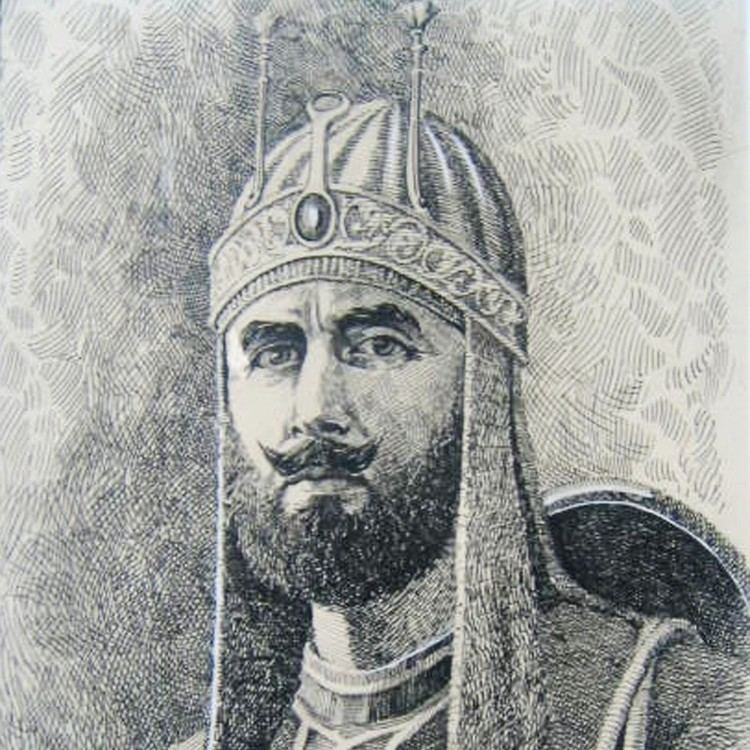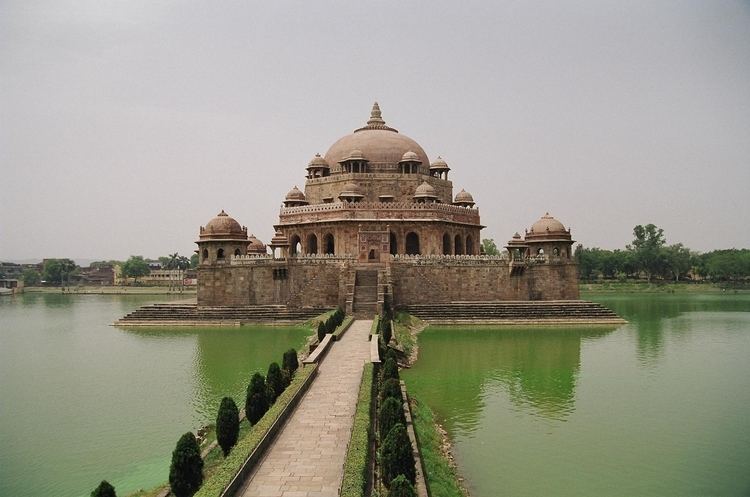Coronation 1540 Name Sher Suri | Issue Jalal Khan Full name Farid Khan Spouse Rani Shah (m. ?–1545) | |
 | ||
Reign 17 May 1540 – 15 May 1545 Died May 22, 1545, Kalinjar Fort Similar People | ||
Sher shah suri
Sher Shah Suri (1486–22 May 1545) was the founder of the Sur Empire in North India, with its capital at Delhi. An ethnic Pashtun, Sher Shah took control of the Mughal Empire in 1540. After his accidental death in 1545, his son Islam Shah became his successor. He first served as a private before rising to become a commander in the Mughal army under Babur and then the governor of Bihar. In 1537, when Babur's son Humayun was elsewhere on an expedition, Sher Shah overran the state of Bengal and established the Sur dynasty. A brilliant strategist, Sher Shah proved himself as a gifted administrator as well as a capable general. His reorganization of the empire laid the foundations for the later Mughal emperors, notably Akbar, son of Humayun.
Contents
- Sher shah suri
- History of Sher Shah Suri in Urdu Hindi
- Early life and origin
- Conquest of Bihar and Bengal
- Conquest of Malwa
- Conquest of Rajputana
- Government and administration
- Death and succession
- Karachi
- References

During his five-year rule from 1540 to 1545, he set up a new civic and military administration, issued the first Rupiya and re-organised the postal system of India. He further developed Humayun's Dina-panah city and named it Shergarh and revived the historical city of Pataliputra, which had been in decline since the 7th century CE, as Patna. He extended the Grand Trunk Road from Chittagong in the frontiers of the province of Bengal in northeast India to Kabul in Afghanistan in the far northwest of the country.

History of Sher Shah Suri in Urdu & Hindi
Early life and origin
Sher Shah Suri was born as Farid Khan in the present day place Sasaram in the state of Bihar in India. His surname 'Suri' was taken from his Sur tribe. The name Sher (tiger) was conferred upon him when, as a young man, he killed a tiger that leapt suddenly upon the king of Bihar. His grand father Ibrahim Khan Suri was a land lord (Jagirdar) in Narnaul area and represented Delhi rulers of that period. Mazar of Ibrahim Khan Suri still stands as a monument in Narnaul. Tarikh-i Khan Jahan Lodi (MS. p. 151). also confirm this fact. However, the online Encyclopædia Britannica states that he was born in Sasaram (Bihar), in the Rohtas district. He was one of about eight sons of Mian Hassan Khan Suri, a prominent figure in the government of Bahlul Khan Lodi in Narnaul Pargana. Sher Khan belonged to the Pashtun Sur tribe. His grandfather, Ibrahim Khan Suri, was a noble adventurer from Roh who was recruited much earlier by Sultan Bahlul Lodi of Delhi during his long contest with the Jaunpur Sultanate.

It was at the time of this bounty of Sultán Bahlol, that the grandfather of Sher Sháh, by name Ibráhím Khán Súri,*[The Súr represent themselves as descendants of Muhammad Súri, one of the princes of the House of the Ghorian, who left his native country, and married a daughter of one of the Afghán chiefs of Roh.] with his son Hasan Khán, the father of Sher Sháh, came to Hindu-stán from Afghánistán, from a place which is called in the Afghán tongue "Shargarí,"* but in the Multán tongue "Rohrí." It is a ridge, a spur of the Sulaimán Mountains, about six or seven kos in length, situated on the banks of the Gumal. They entered into the service of Muhabbat Khán Súr, Dáúd Sáhú-khail, to whom Sultán Bahlol had given in jágír the parganas of Hariána and Bahkála, etc., in the Panjáb, and they settled in the pargana of Bajwára.

During his early age, Farid was given a village in Fargana, Delhi (comprising present day districts of Bhojpur, Buxar, Bhabhua of Bihar) by Omar Khan Sarwani, the counselor and courtier of Bahlul Khan Lodi. Farid Khan and his father, a jagirdar of Sasaram in Bihar, who had several wives, did not get along for a while so he decided to run away from home. When his father discovered that he fled to serve Jamal Khan, the governor of Jaunpur, Uttar Pradesh, he wrote Jamal Khan a letter that stated:
Faríd Khán, being annoyed with me, has gone to you without sufficient cause. I trust in your kindness to appease him, and send him back; but if refusing to listen to you, he will not return, I trust you will keep him with you, for I wish him to be instructed in religious and polite learning.
Jamal Khan had advised Farid to return home but he refused. Farid replied in a letter:
If my father wants me back to instruct me in learning, there are in this city many learned men: I will study here.
Conquest of Bihar and Bengal
Farid Khan started his service under Bahar Khan Lohani, the Mughal Governor of Bihar. Because of his valour, Bahar Khan rewarded him the title Sher Khan (Tiger Lord). After the death of Bahar Khan, Sher Khan became the regent ruler of the minor Sultan, Jalal Khan. Later sensing the growth of Sher Shah's power in Bihar, Jalal sought the assistance of Ghiyasuddin Mahmud Shah, the independent Sultan of Bengal. Ghiyasuddin sent an army under General Ibrahim Khan. But, Sher Khan defeated the force at the battle of Surajgarh in 1534 after forming an alliance with Ujjainiya Rajputs and other local chiefdoms. Thus he achieved complete control of Bihar.
In 1538, Sher Khan attacked Bengal and defeated Ghiyashuddin Shah. But he could not capture the kingdom because of the sudden expedition of Emperor Humayun. On 26 June 1539, Sher Khan faced Humayun in the Battle of Chausa and defeated him. Assuming the title Farīd al-Dīn Shēr Shah, he defeated Humayun once again at Kannauj in May 1540 and forced him out of India.
Conquest of Malwa
After the death of Bahadur Shah of Gujarat in 1537, Qadir Shah became the new ruler of Malwa Sultanate. He then turned for support towards the Rajput and Muslim noblemen of the Khilji rule of Malwa. Bhupat Rai and Puran Mal, sons of Raja Silhadi accepted service under the regime of Malwa in recognition of their interest in the Raisen region. By 1540, Bhupat Rai had died and Puran Mal had become the dominant force in eastern Malwa. In 1542, Sher Shah conquered Malwa without a fight and Qadir Shah fled to Gujarat. He then appointed Shuja'at Khan as the governor of Malwa who reorganised the administration and made Sarangpur the seat of Malwa's government. Sher Shah then ordered Puran Mal to be brought before him. Puran Mal agreed to accept his lordship and left his brother Chaturbhuj under Sher Shah's service. In exchange Sher Shah vowed to safeguard Puran Mal and his land. The Muslim women of Chanderi, which Sher Shah took under his rule, came to him and accused Puran Mal of killing their husbands and enslaving their daughters. They threatened to accuse the sultan on the Day of Resurrection if he did not avenge them. Upon reminding them of his vow for Puran Mal's safety, they told him to consult his ulema. The ulema issued a fatwa declaring that Puran Mal deserved death for this act. Sher Shah's troops then surrounded Puran Mal's fortress at Raisen. Upon seeing this, Puran Mal beheaded his wife and ordered the Rajputs to kill their families as he might have thought that personal honor was involved because of his lord going back on his promise. After this, the Rajputs then went into battle and all of them were killed by Sher Shah's troops. `Abd al-Qadir Bada'uni puts the number of Rajputs to 10,000 while Nizamuddin Ahmad puts it to 4,000.
Conquest of Rajputana
In 1543, Sher Shah Suri with a huge force of 80,000 cavalry set out against Maldeo Rathore (a Rajput king of Marwar). Maldeo Rathore with an army of 50,000 cavalry advanced to face Sher Shah's army. Instead of marching to the enemy's capital Sher Shah halted in the village of Sammel in the pargana of Jaitaran, ninety kilometers east of Jodhpur. After one month, Sher Shah's position became critical owing to the difficulties of food supplies for his huge army. To resolve this situation, Sher Shah resorted to a cunning ploy. One evening, he dropped forged letters near the Maldeo's camp in such a way that they were sure to be intercepted. These letters indicated, falsely, that some of Maldeo's army commanders were promising assistance to Sher Shah. This caused great consternation to Maldeo, who immediately (and wrongly) suspected his commanders of disloyalty. Maldeo left for Jodhpur with his own men, abandoning his commanders to their fate.
After that Maldeo's innocent generals Jaita and Kunpa fought with just 20,000 men against an enemy force of 80,000 men. In the ensuing battle of Sammel (also known as battle of Giri Sumel), Sher Shah emerged victorious, but several of his generals lost their lives and his army suffered heavy losses. Sher Shah is said to have commented that "for a few grains of bajra (millet, which is the main crop of barren Marwar) I almost lost my entire kingdom."
After this victory, Sher Shah's general Khawas Khan Marwat took possession of Jodhpur and occupied the territory of Marwar from Ajmer to Mount Abu in 1544.
Government and administration
The system of tri-metalism which came to characterise Mughal coinage was introduced by Sher Shah. While the term rūpya had previously been used as a generic term for any silver coin, during his rule the term rūpiya came to be used as the name for a silver coin of a standard weight of 178 grains, which was the precursor of the modern rupee. Rupee is today used as the national currency in India, Indonesia, Maldives, Mauritius, Nepal, Pakistan, Seychelles, Sri Lanka among other countries. Gold coins called the Mohur weighing 169 grains and copper coins called Dam were also minted by his government.
Sher Shah built monuments including Rohtas Fort (now a UNESCO World Heritage Site in Pakistan), many structures in the Rohtasgarh Fort in Bihar, Sher Shah Suri Masjid, in Patna, built in 1540–1545 to commemorate his reign. He built a new city Bhera of Pakistan in 1545 and inside the city built historical grand Sher Shah Suri Masjid.}
Qila-i-Kuhna mosque, built by Sher Shah in 1541, at Purana Qila, Delhi, a Humayun citadel started in 1533, and later extended by him, along with the construction of Sher Mandal, an octagonal building inside the Purana Qila complex, which later served as the library of Humayun.
Tarikh-i-Sher Shahi (History of Sher Shah), written by Abbas Khan Sarwani, a waqia-navis under later Mughal Emperor, Akbar around 1580, provides a detailed documentation about Sher Shah's administration.
Death and succession
Sher Shah was killed on 22 May 1545 during the siege of the Kalinjar fort of Rajputs. When all tactics to subdue this fort failed, Sher Shah ordered the walls of the fort to be blown up with gunpowder, but he himself was seriously wounded as a result of the explosion of a mine. He was succeeded by his son, Jalal Khan, who took the title of Islam Shah Suri. His mausoleum, the Sher Shah Suri Tomb (122 ft high), stands in the middle of an artificial lake at Sasaram, a town on the Grand Trunk Road.
Karachi
Sher Shah neighbourhood and Sher Shah Bridge in Kiamari Town of Karachi, Sher Shah Road in Multan cantt and Sher Shah Park in Wah Cantt, Pakistan, are named in the honour of Sher Shah Suri.
